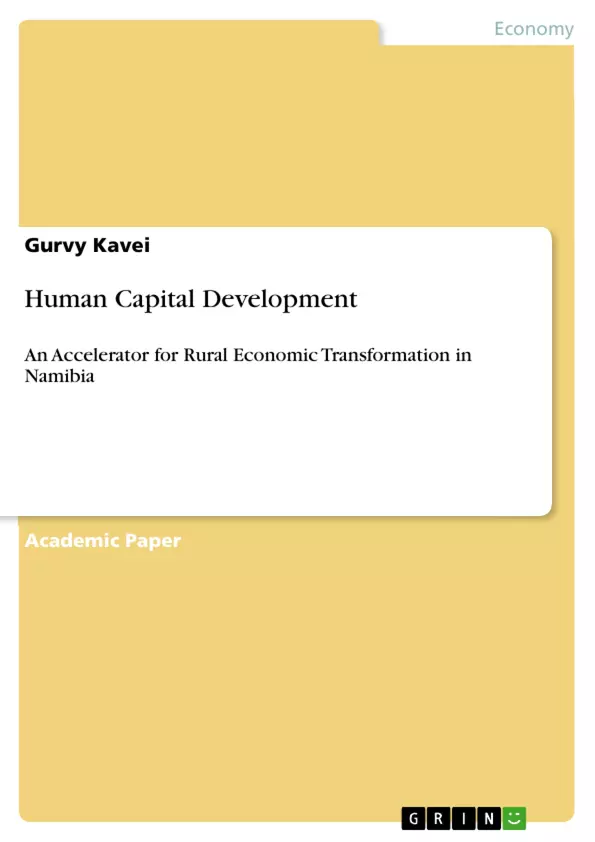This paper explores the critical role of human capital development in driving rural economic transformation in Namibia. Using a mixed method of policy gap analysis, informed group consultations and semi-structured interviews, it delves into the strengths, weaknesses, opportunities, and threats related to human capital development in rural areas, emphasizing the significance of community-based education initiatives, government support programs, and traditional knowledge and skills. Additionally, the paper examines the policy environment and gaps, challenges, and cross-cutting issues associated with human capital development in rural Namibia. It recommends for an integrated cross-sectoral policy framework to enforce institutional commitments at rural development level. Furthermore, the paper highlights the need for increased investment in education and training, promotion of entrepreneurship and innovation, and addressing gender disparities in access to education and training as essential strategies for advancing human capital development in rural Namibia. Multi-disciplinary and multi-sectoral research in the future would suffice to unravel the challenge of rural transformation from different perspectives
Inhaltsverzeichnis (Table of Contents)
- Abstract
- Introduction
Zielsetzung und Themenschwerpunkte (Objectives and Key Themes)
This paper aims to explore the crucial role of human capital development in fostering rural economic transformation within Namibia. It investigates the strengths, weaknesses, opportunities, and threats related to human capital development in rural areas, focusing on community-based initiatives, government programs, and traditional knowledge. The analysis also examines the policy environment and identifies challenges and cross-cutting issues.
- The significance of human capital development in driving rural economic transformation in Namibia.
- Analysis of the policy environment and its impact on human capital development in rural areas.
- Challenges and opportunities related to human capital development in rural Namibia.
- The role of community-based education initiatives and government support programs.
- Strategies for advancing human capital development, including investment in education and addressing gender disparities.
Zusammenfassung der Kapitel (Chapter Summaries)
Abstract: This abstract provides a concise overview of the paper, highlighting its focus on the critical role of human capital development in driving rural economic transformation in Namibia. It mentions the methodology used (a mixed method of policy gap analysis, group consultations, and semi-structured interviews) and emphasizes the importance of community-based education, government support, and traditional knowledge. The abstract also points to the examination of policy gaps, challenges, and cross-cutting issues, ultimately recommending an integrated policy framework and increased investment in education and training to address gender disparities.
Introduction: This introductory chapter sets the stage by emphasizing the significant contribution of the Namibian rural economy to the overall national economy, particularly the role of agriculture. It highlights the importance of achieving SDG 2 (zero hunger) and food security. The chapter introduces the considerable potential of rural economies for growth, employment, and empowerment, while also acknowledging the stark reality of high poverty rates in rural Namibia compared to urban areas. It references the Kinshasa Declaration on Rural Transformation and its goals for rural economic transformation, emphasizing the need for Member States to mainstream rural development into national strategies. The chapter concludes by illustrating the existing challenges and the need for impactful interventions in the rural context.
Schlüsselwörter (Keywords)
Human capital development, Namibia, rural economic transformation, policy environment, challenges, opportunities, cross-cutting issues, investment in education, gender disparities, rural poverty, unemployment, agriculture, sustainable development goals (SDGs).
Häufig gestellte Fragen
Was ist das Hauptthema des Inhaltsverzeichnisses?
Das Hauptthema ist die Entwicklung von Humankapital und dessen Rolle bei der Förderung des ländlichen wirtschaftlichen Wandels in Namibia.
Was sind die Hauptziele der Arbeit?
Die Arbeit zielt darauf ab, die entscheidende Rolle der Humankapitalentwicklung bei der Förderung des ländlichen wirtschaftlichen Wandels in Namibia zu untersuchen. Sie untersucht die Stärken, Schwächen, Chancen und Bedrohungen im Zusammenhang mit der Humankapitalentwicklung in ländlichen Gebieten und konzentriert sich dabei auf gemeindebasierte Initiativen, Regierungsprogramme und traditionelles Wissen.
Welche Schwerpunkte werden in der Analyse gesetzt?
Die Analyse konzentriert sich auf die Bedeutung der Humankapitalentwicklung für den ländlichen wirtschaftlichen Wandel, die Analyse des politischen Umfelds, Herausforderungen und Chancen, die Rolle gemeindebasierter Bildungsinitiativen und staatlicher Unterstützungsprogramme sowie Strategien zur Förderung der Humankapitalentwicklung, einschließlich Investitionen in Bildung und die Beseitigung von Geschlechterunterschieden.
Was wird im Abstract zusammengefasst?
Das Abstract bietet einen prägnanten Überblick über die Arbeit, wobei der Schwerpunkt auf der entscheidenden Rolle der Humankapitalentwicklung bei der Förderung des ländlichen wirtschaftlichen Wandels in Namibia liegt. Es erwähnt die verwendete Methodik (eine gemischte Methode aus politischer Lückenanalyse, Gruppenkonsultationen und halbstrukturierten Interviews) und betont die Bedeutung von gemeindebasierter Bildung, staatlicher Unterstützung und traditionellem Wissen.
Was wird in der Einleitung behandelt?
Die Einleitung betont den bedeutenden Beitrag der namibischen ländlichen Wirtschaft zur gesamten Volkswirtschaft, insbesondere die Rolle der Landwirtschaft. Sie hebt die Bedeutung der Erreichung von SDG 2 (kein Hunger) und Ernährungssicherheit hervor. Sie stellt das beträchtliche Potenzial ländlicher Volkswirtschaften für Wachstum, Beschäftigung und Empowerment vor und erkennt gleichzeitig die hohe Armut in ländlichen Namibia im Vergleich zu städtischen Gebieten an.
Welche Schlüsselwörter werden verwendet?
Die Schlüsselwörter sind: Humankapitalentwicklung, Namibia, ländlicher wirtschaftlicher Wandel, politisches Umfeld, Herausforderungen, Chancen, Querschnittsthemen, Investitionen in Bildung, Geschlechterunterschiede, ländliche Armut, Arbeitslosigkeit, Landwirtschaft, Ziele für nachhaltige Entwicklung (SDGs).
- Citation du texte
- Gurvy Kavei (Auteur), 2024, Human Capital Development, Munich, GRIN Verlag, https://www.grin.com/document/1522519



